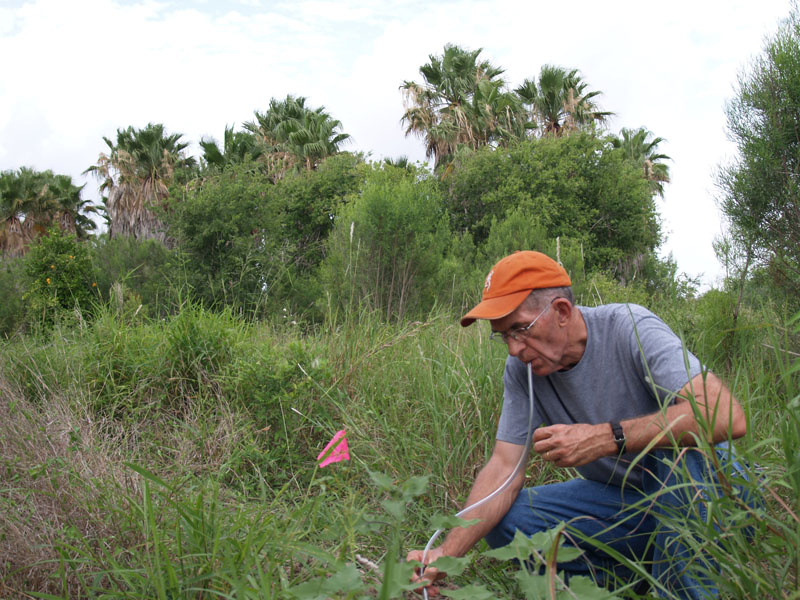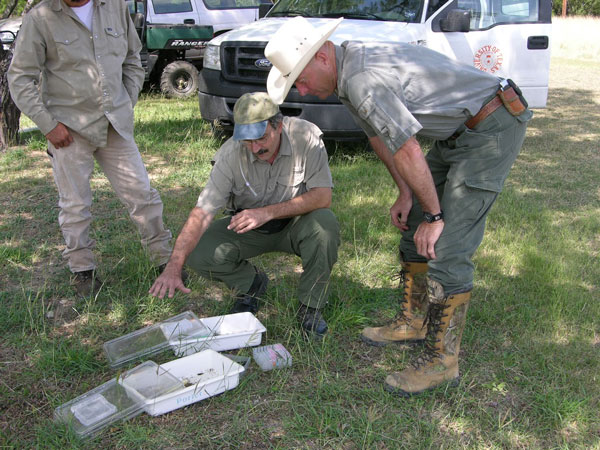To combat and manage pesky invasive species such as fire ants, tawny crazy ants and Cactoblastis moths, the Texas Invasive Species Program has been established at The University of Texas at Austin with $2.7 million in support from the Lee and Ramona Bass Foundation.
 Professor Larry Gilbert collects phorid flies for his research on the invasive red imported fire ant in South Texas.
Professor Larry Gilbert collects phorid flies for his research on the invasive red imported fire ant in South Texas.The six-year grant will enable researchers at the College of Natural Sciences’ Brackenridge Field Laboratory (BFL) to study the basic biology of exotic invasive pests in their native lands and seek novel and sustainable approaches to countering problem organisms that threaten biodiversity in the central and southern parts of Texas.
“I consider an invasive species program to be the ecological equivalent to a cancer research center in biomedicine,” said Larry Gilbert, professor of integrative biology and director of BFL. “In a planet whose ecosystems are increasingly stressed by human activity and invaded by nonnative species, the conservation of biodiversity requires understanding how to manage ecosystems in the face of these realities.”
The new program builds on previous work by the Texas Fire Ant Lab to study the potential for natural biocontrols of the invasive fire ant, Solenopsis invicta. Gilbert and his colleagues have been studying parasitic phorid flies (Pseudacteon sp.) from the ant’s native range in South America for more than two decades. The flies kill the ants and disrupt their food foraging, which makes the ants less efficient and improves the competitiveness of native ant species.
 Dr. Rob Plowes shows Texas rancher Don Berg phorid flies attacking invasive imported fire ants.
Dr. Rob Plowes shows Texas rancher Don Berg phorid flies attacking invasive imported fire ants.
The researchers will also study other current and future invasive species, such as the Cactoblastis moth from Argentina, which feeds on native prickly pear cacti; Buffelgrass, an African grass that is crowding out native plants and affecting wildlife; and the tawny crazy ant, a recent invader from South America that is capable of reaching incredible densities and has even been found to displace fire ants.
In fact, researchers at BFL recently found that tawny crazy ants are reducing the diversity and abundance of ant and arthropod species in some Gulf Coast areas, threatening the stability of the ecosystem as a whole.
Researchers affiliated with the Texas Invasive Species program include Rob Plowes and Ed LeBrun, research scientists in the ant group at BFL; Patricia Folgarait, a collaborator from the National University of Quilmes in Argentina; and microbial ecologist Christine Hawkes, an associate professor of integrative biology at The University of Texas at Austin. The Bass funding will also involve collaboration with Kenyan scientists and continued work in Argentina.
Gilbert stresses that the work that he and his fellow researchers conduct would not be possible without the help of donors and the many landowners who have provided access to their properties for research.
“We would not be in this position without the ongoing support from the Lee and Ramona Bass Foundation and past long-term support of the Robert J. Kleberg and Helen C. Kleberg Foundation,” said Gilbert. “These are family foundations whose members have strong involvement with ranching, wildlife and private conservation efforts and share our group's interest in protecting the biodiversity of Texas through sustainable control and management of problem invasive species.”
For more information, contact: Lawrence Gilbert, Section of Integrative Biology, College of Natural Sciences, 512-471-4705; Lee Clippard, College of Natural Sciences, 512-232-0675

















Comments